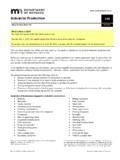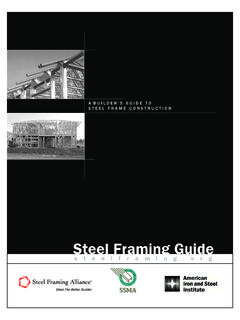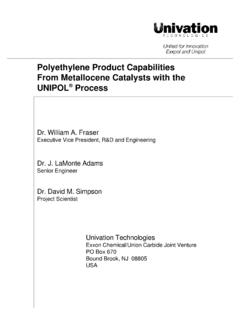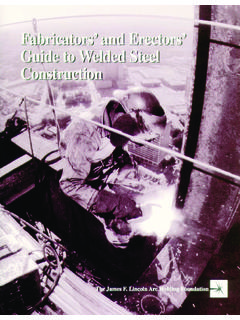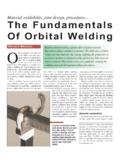Transcription of HOW EFFECTIVE SCRAP MANAGEMENT PROCEDURES …
1 ITS YOUR REVENUE MACHINE White Paper DON T JUST DISPOSE OF YOUR SCRAP - MANAGE IT HOW EFFECTIVE SCRAP MANAGEMENT PROCEDURES create A REVENUE MACHINE FOR YOUR BUSINESS ITS YOUR REVENUE MACHINE Abstract It is unfortunate, but many companies in the United States don t take advantage of the financial opportunities that SCRAP material from their production process presents. They think of this material as a necessary evil of their business without understanding the benefits and security that a professional SCRAP MANAGEMENT program can provide. Often, the person in charge of selling SCRAP metal is actually a purchasing professional. They are tasked with reducing pricing for raw materials and are very qualified in the purchasing of goods and services but are not trained in selling metals or SCRAP metal recycling.
2 More than likely they don't have access to some very important market information that can generate a great deal of additional revenue for their company. They also don't have the experience in segregation and upgrade opportunities that a trained recycling professional has. Lack of information can be extremely costly. It is not necessarily the fault of your employees, they just don t have access to the most up to date market data. Most companies don't necessarily rely on SCRAP to generate profits; they base their business on providing quality goods and services to their customers. In addition, manufacturers may leave money on the table because they don't adequately track and control the SCRAP they are selling. They may not be aware of simple, cost- EFFECTIVE practices such as knowing the grade, weight, and value of their SCRAP that can increase their revenue. In selling SCRAP , the following two principles rule: 1.
3 Know what you're selling versus what you're getting paid for. 2. Incorporate sorting and cleaning in your production stream to reduce the sorting and cleaning costs your recycler must subtract from your price per pound. It is important to not only look at the monetary impact but also how to avoid the potentially high costs of mishandling your SCRAP material. How well do you know your current SCRAP vendors policies and PROCEDURES ? Do you know how your material is handled after it leaves your facility? The answers to these questions are critical to protect your business from environmental, safety, or potential confidentiality concerns. ITS YOUR REVENUE MACHINE Contents 1. The importance of cleaning and sorting SCRAP material 2. Understanding the grading of SCRAP material and its financial benefits 3. Managing shipping and handling 4.
4 Creating an audit trail 5. Environmental responsibilities 6. Protecting proprietary material 7. Summary and contact information ITS YOUR REVENUE MACHINE SCRAP preparation, cleaning, and sorting The more uniform and contaminant-free that SCRAP is when fabricators provide it to recyclers, the more fabricators can benefit. Prepare SCRAP for selling it as you produce it. Mixed and contaminated SCRAP sells for far less than sorted and clean SCRAP . The simplest form of sorting is not to mix items in the first place. Keep turnings separate from cutoffs, punchings, and sheets. Don't downgrade premium materials by mixing them with low-grade materials. Put brass, steel, stainless, aluminum, etc., in individual containers a drum of copper turnings in a load of steel turnings could possibly make the whole load worthless. Also segregate alloys of the same metal; different alloys of aluminum, for example, may have the same SCRAP value individually, but their value decreases if they are mixed.
5 Segregate also by size. Slit coil stock, for example, sells for more if you cut it into its most marketable size because this increases the density of the material in the containers. In turn, handling and freight costs for you and your recycler will decrease. Using the correct size containers (available from your recycler) at your facility will help maximize your revenue. Be sure that they are serial numbered so that you can track and audit your payment later. SCRAP loses value if it is excessively contaminated with lubricants and cutting fluids. Reclaiming fluids by draining or spinning not only increases your SCRAP value, but you may be able to reuse them. When switching from one metal to another in a machine, no matter how well you clean, some old material will be caught in the machine. Therefore, keep the first container of SCRAP from the new run to be sold as mixed. ITS YOUR REVENUE MACHINE Value of Sorting and Cleaning What is the value to you of SCRAP as you create it compared to adding the processes of the SCRAP being sorted and cleaned?
6 Sorting at the machines of origin is usually inexpensive, even though some new equipment and training may be involved. The cost of cutting SCRAP to premium sizes may slightly increase labor, however, because fewer labor-hours are needed to load and move the same weight with fewer pickups, the unit price you receive increases. Segregating, sorting, and cleaning SCRAP pays off. SIR can examine your operations and make specific recommendations regarding optimum container sizes and styles, crusher and spinner systems, material handling equipment, emergency services, optimum pickup schedules, and environmental practices. Some examples of benefits we offer our clients are below. The top left photo is an example of steel busheling and the top right is steel clip. To the untrained eye they look the same but there can be a $30 per gross ton or more price difference. The copper on the bottom left is #2 due to the solder on the joints and the copper on the right is clean of solder so it is considered #1.
7 Again, it s not easy to pick out but it can be as much as a $.25 per lb. price difference! Steel Busheling Steel Clip #2 Copper #1 Copper ITS YOUR REVENUE MACHINE Shipping and Handling The most important step in protecting the value of your SCRAP is keeping track of it from the point of origin in your plant to your recycler's facility. Frequently, fabricators let shipping dock workers dispose of their SCRAP . If they can't or don't grade your SCRAP accurately, they really don't know what's in the containers, so it could possibly be downgraded, and you get the minimum value. Unfortunately there is also a need to monitor your employees to ensure they are not involved in removing SCRAP from your facility without your knowledge.
8 A dockhand can sign for a container of aluminum and a container of steel, but container weights could accidently be switched on the receiving end. The actual SCRAP material price is meaningless unless you have a way of reconciling all the pounds before and after they leave your facility. Certified scale ticket SCRAP receiving document create an Audit Trail An audit trail is complete documentation to authenticate the amount and sale of your SCRAP . This documentation can also provide specific SCRAP ratio information that can be used to improve employee performance on individual machines or shifts. To create a trail, use only serial-numbered containers, and weigh each container in your plant before it's picked up. create a bill of lading that records the gross, tare, and net weights, along with the container serial numbers and the material actually inside the container by commodity, grade, piece sizes, and cleanliness.
9 The driver who picks up your containers should sign the bills of lading with a legible signature. He/ she also should provide a pickup receipt showing the truck number, the container number(s), time and date of pickup, and the signature of someone from your plant. When the load arrives at the recycler's facility, the receiver again should weigh the load electronically and then generate a numbered scale ticket for each container showing the gross, tare, and net weights, as well as the contents, your bill of lading number, the container number picked up, and the time and date. The recycler should send this scale ticket along with your payment check so that you can be sure that you're being paid for the actual quality and weight of your SCRAP . Make sure the certified scale ticket reconciles with the receiving documents from your SCRAP vendor. Also compare the unit prices published in the trade papers with what you're being paid.
10 ITS YOUR REVENUE MACHINE Downstream Environmental Liability A new factor in SCRAP MANAGEMENT is that government regulations and case law now impose liability on fabricators for safe handling of their SCRAP all the way to remelt in primary metals mills. The government doesn't want SCRAP processors hauling containers leaking fluids on the highways or dumping SCRAP containing free-flowing fluids in recyclers' yards. Downstream liability can come back to haunt fabricators years, even decades, after selling SCRAP if that SCRAP has caused environmental damage; courts have held that fabricators are potentially responsible parties because contaminants in SCRAP they shipped to dealers contributed to the cleanup. Because some fluid always will cling to SCRAP , the metal recycler's facility should be designed to process and ship your material properly. ITS YOUR REVENUE MACHINE Protect Proprietary Inventory All fabricators produce some finished goods that become obsolete, don't pass quality control, are prototypes, or possibly even customer returns.

